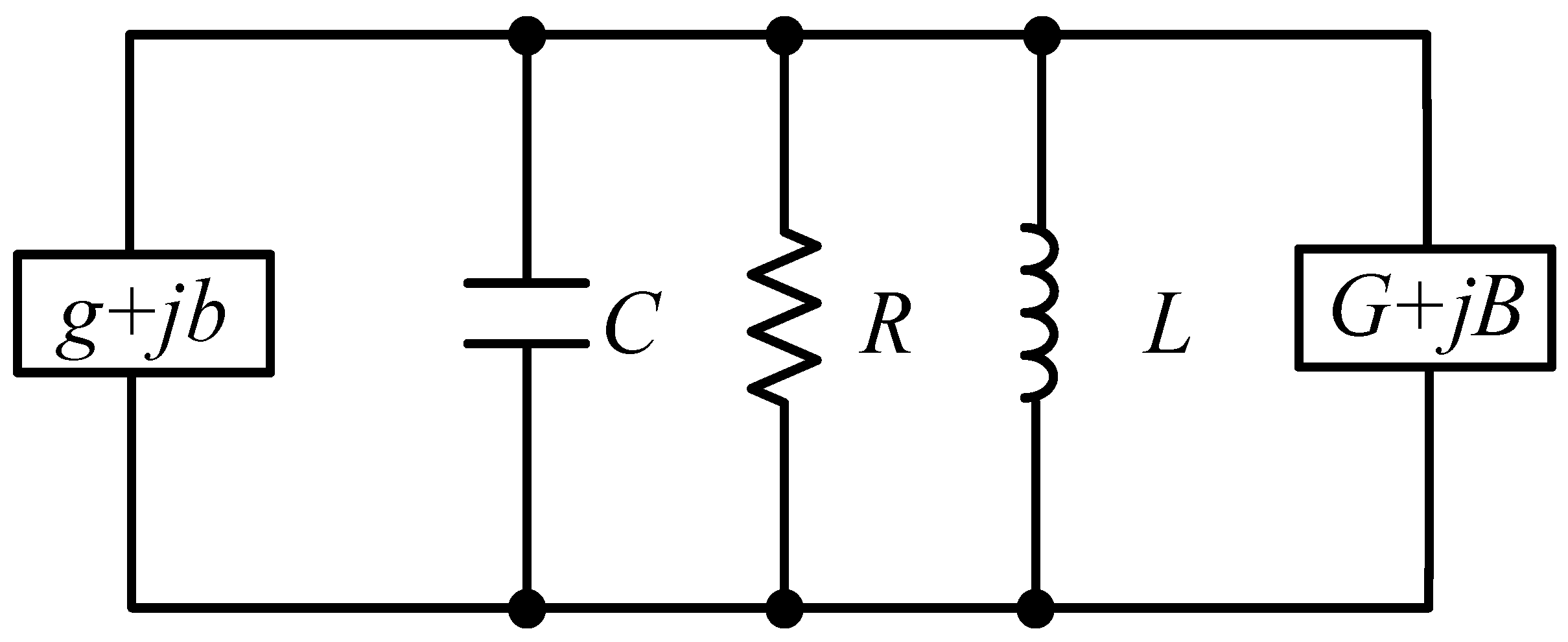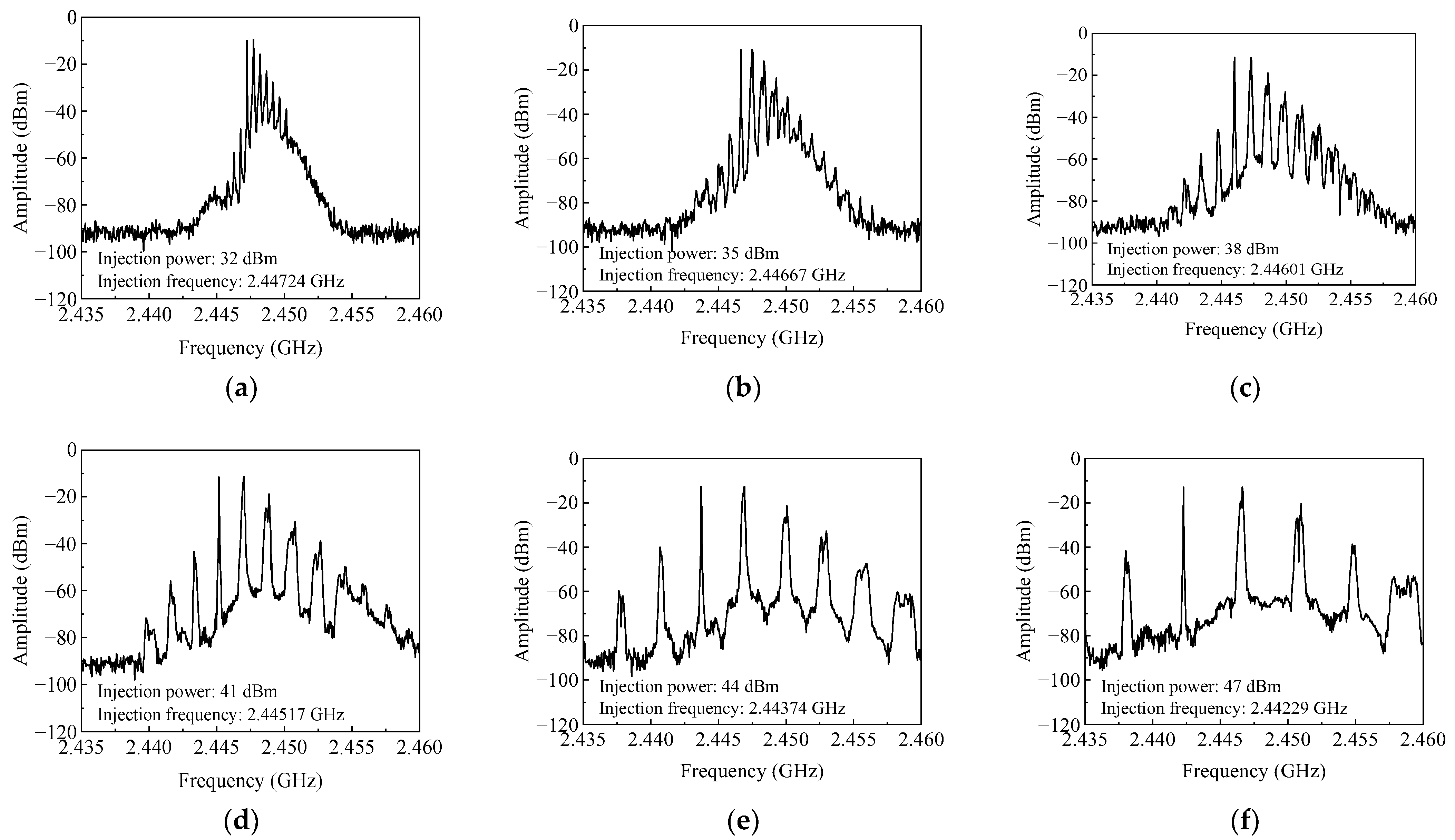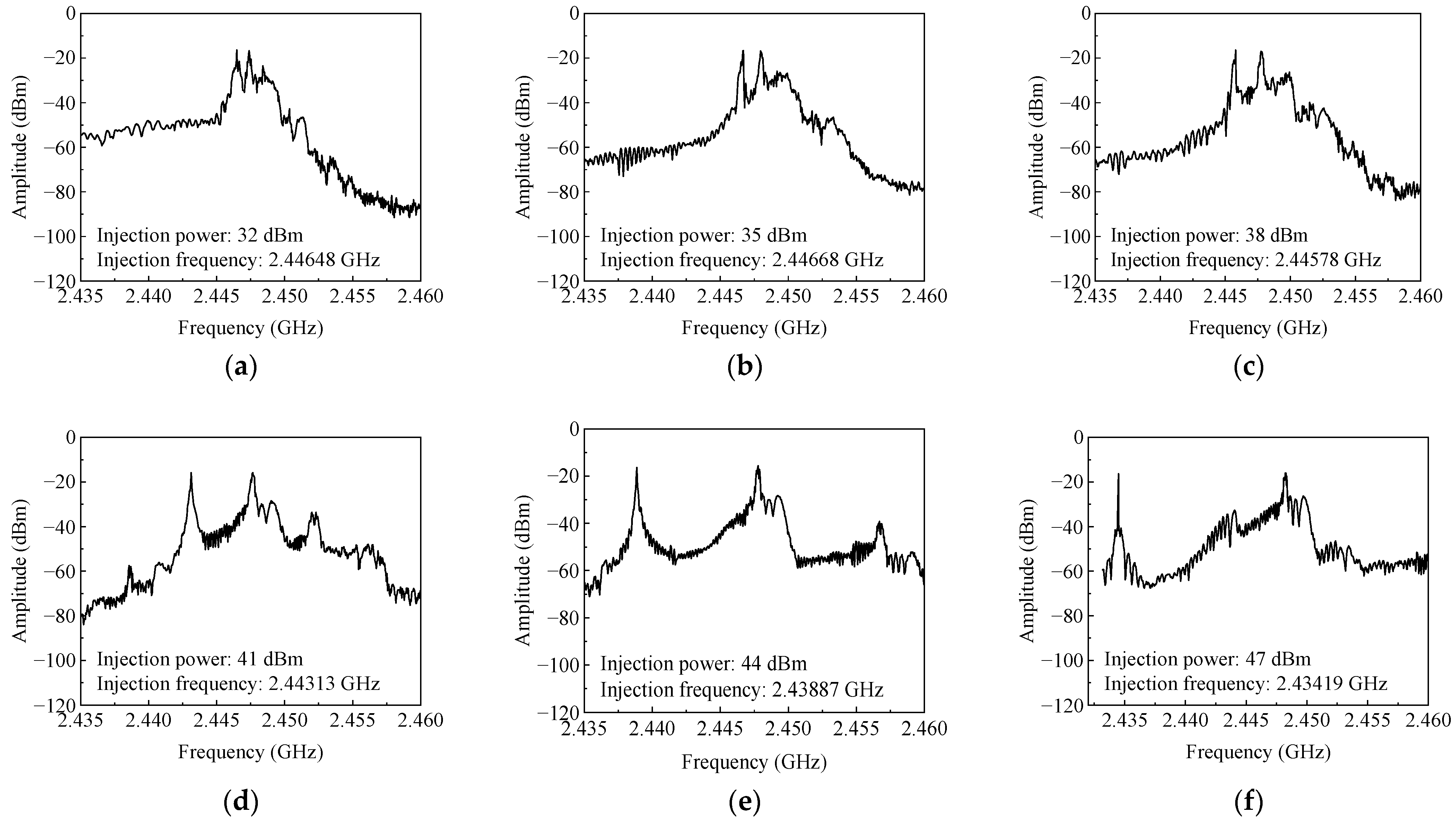Experimental Study of Magnetron’s Power-Pulled Characteristic to Realize a Quasi-Dual-Frequency Microwave Output
Abstract
1. Introduction
2. Theoretical and Numerical Analysis
2.1. Injection Locking of a Magnetron
2.2. Numerical Analysis
3. Experimental Configuration
4. Results and Discussion
5. Conclusions
Author Contributions
Funding
Data Availability Statement
Conflicts of Interest
References
- Gonzalez Rivera, J.; Pulidori, E.; Pelosi, C.; Ferrari, C.; Bernazzani, L.; Tinè, M.R.; Bramanti, E.; Duce, C. 20 Years of Microwave Technology Developments Using a Coaxial Antenna: From Human Health to Green Chemistry Applications. Curr. Res. Green Sustain. Chem. 2022, 5, 100337. [Google Scholar] [CrossRef]
- Ye, J.; Zhang, C.; Zhu, H. A Temperature-Control System for Continuous-Flow Microwave Heating Using a Magnetron as Microwave Source. IEEE Access 2020, 8, 44391–44399. [Google Scholar] [CrossRef]
- Ikenaga, K.; Inoue, T.; Kusakabe, K. Hydrolysis of PET by Combining Direct Microwave Heating with High Pressure. Procedia Eng. 2016, 148, 314–318. [Google Scholar] [CrossRef]
- Bae, S.-H.; Jeong, M.-G.; Kim, J.-H.; Lee, W.-S. A Continuous Power-Controlled Microwave Belt Drier Improving Heating Uniformity. IEEE Microw. Wirel. Compon. Lett. 2017, 27, 527–529. [Google Scholar] [CrossRef]
- Li, Z.Y.; Wang, R.F.; Kudra, T. Uniformity Issue in Microwave Drying. Dry. Technol. 2011, 29, 652–660. [Google Scholar] [CrossRef]
- Antonio, C.; Deam, R.T. Comparison of Linear and Non-Linear Sweep Rate Regimes in Variable Frequency Microwave Technique for Uniform Heating in Materials Processing. J. Mater. Process. Technol. 2005, 169, 234–241. [Google Scholar] [CrossRef]
- Du, Z.; Wu, Z.; Gan, W.; Liu, G.; Zhang, X.; Liu, J.; Zeng, B. Multi-Physics Modeling and Process Simulation for a Frequency-Shifted Solid-State Source Microwave Oven. IEEE Access 2019, 7, 184726–184733. [Google Scholar] [CrossRef]
- Ku, H.S.-L.; Yusaf, T. Processing of Composites Using Variable and Fixed Frequency Microwave Facilities. Prog. Electromagn. Res. B 2008, 5, 185–205. [Google Scholar] [CrossRef]
- Bows, J.R. Variable Frequency Microwave Heating of Food. J. Microw. Power Electromagn. Energy 1999, 34, 227–238. [Google Scholar] [CrossRef]
- Yakovlev, V.V. Frequency Control over the Heating Patterns in a Solid-State Dual-Source Microwave Oven. In Proceedings of the 2015 IEEE MTT-S International Microwave Symposium, Phoenix, AZ, USA, 17–22 May 2015; IEEE: Piscataway, NJ, USA, 2015; pp. 1–4. [Google Scholar] [CrossRef]
- Chen, X.; Yang, B.; Shinohara, N.; Liu, C. Low-Noise Dual-Way Magnetron Power-Combining System Using an Asymmetric H-Plane Tee and Closed-Loop Phase Compensation. IEEE Trans. Microw. Theory Techn. 2021, 69, 2267–2278. [Google Scholar] [CrossRef]
- Huang, H.; Yang, B.; Shinohara, N.; Liu, C. Coherent Power Combining of Four-Way Injection-Locked 5.8-GHz Magnetrons Based on a Five-Port Hybrid Waveguide Combiner. IEEE Trans. Microw. Theory Techn. 2024, 1–10. [Google Scholar] [CrossRef]
- Liu, Z.; Chen, X.; Yang, M.; Wu, P.; Huang, K.; Liu, C. Experimental Studies on a Four-Way Microwave Power Combining System Based on Hybrid Injection-Locked 20-kW S-Band Magnetrons. IEEE Trans. Plasma Sci. 2019, 47, 243–250. [Google Scholar] [CrossRef]
- Wang, S.; Shen, Y.; Liao, C.; Jing, J.; Liu, C. A Novel Injection-Locked S-Band Oven Magnetron System Without Waveguide Isolators. IEEE Trans. Electron Devices 2023, 70, 1886–1893. [Google Scholar] [CrossRef]
- Liu, C.; Wang, S.; Yan, L. Injection-Locked Magnetron System Based on Filament Injection. U.S. Patent No. 11,842,878, 12 December 2023. [Google Scholar]
- Yang, B.; Mitani, T.; Shinohara, N. Evaluation of the Modulation Performance of Injection-Locked Continuous-Wave Magnetrons. IEEE Trans. Electron Devices 2019, 66, 709–715. [Google Scholar] [CrossRef]
- Chen, X.; Yu, Z.; Lin, H.; Zhao, X.; Liu, C. Improvements in a 20-kW Phase-Locked Magnetron by Anode Voltage Ripple Suppression. IEEE Trans. Plasma Sci. 2020, 48, 1879–1885. [Google Scholar] [CrossRef]
- Ha, C.-S.; Kim, T.-H.; Jang, S.-R.; Kim, J.-S.; Han, S.-T. Experimental Study on the Effect of the Characteristics of a Switching-Mode Power Supply on a Phase-Locked Magnetron. IEEE Electron Device Lett. 2022, 43, 619–622. [Google Scholar] [CrossRef]
- Yang, F.; Wang, W.; Yan, B.; Hong, T.; Yang, Y.; Zhu, H.; Wu, L.; Huang, K. Sweep Frequency Heating Based on Injection Locked Magnetron. Processes 2019, 7, 341. [Google Scholar] [CrossRef]
- Du, M.; Zhang, Z.; Huang, J.; Zhu, H.; Yang, Y. Study of Multi-Frequency Heating Based on the Nonlinear Response Characteristics of Magnetron to Improve Uniformity. J. Microw. Power Electromagn. Energy 2023, 57, 71–88. [Google Scholar] [CrossRef]
- Slater, J.C. The phasing of magnetrons. In Research Laboratory of Electronics; MIT: Cambridge, MA, USA, 1947; Volume 35. [Google Scholar]
- Chen, S.C. Growth and Frequency Pushing Effects in Relativistic Magnetron Phase-Locking. IEEE Trans. Plasma Sci. 1990, 18, 570–576. [Google Scholar] [CrossRef]
- Wang, S.; Zhao, Y.; Chen, X.; Liu, C. A Novel Stability Improvement Method of S-Band Magnetron Systems Based on Its Anode Current Feature. IEEE Trans. Microw. Theory Techn. 2024, 1–10. [Google Scholar] [CrossRef]
- Adler, R. A Study of Locking Phenomena in Oscillators. Proc. IRE 1946, 34, 351–357. [Google Scholar] [CrossRef]
- Gourary, M.M.; Rusakov, S.G.; Ulyanov, S.L.; Zharov, M.M. Injection Locking/Pulling Analysis of Oscillators under Fractional Excitation Frequency. In Proceedings of the 2011 20th European Conference on Circuit Theory and Design (ECCTD), Linkoping, Sweden, 29–31 August 2011; IEEE: Piscataway, NJ, USA, 2011; pp. 524–527. [Google Scholar] [CrossRef]
- Hong, B.; Hajimiri, A. A General Theory of Injection Locking and Pulling in Electrical Oscillators—Part II: Amplitude Modulation in LC Oscillators, Transient Behavior, and Frequency Division. IEEE J. Solid-State Circuits 2019, 54, 2122–2139. [Google Scholar] [CrossRef]
- Brown, W.C.; Eves, E.E. Beamed Microwave Power Transmission and Its Application to Space. IEEE Trans. Microw. Theory Techn. 1992, 40, 1239–1250. [Google Scholar] [CrossRef]
- Wang, S.; Zhao, Y.; He, Z.; Lan, J.; Yan, L.; Liu, C. Experimental Study on Spurious Suppression Techniques of S-Band Magnetrons. In Proceedings of the 2023 IEEE 7th International Symposium on Electromagnetic Compatibility (ISEMC), Hangzhou, China, 20 October 2023; IEEE: Piscataway, NJ, USA, 2023; pp. 1–3. [Google Scholar]
- Tahir, I.; Dexter, A.; Carter, R. Noise Performance of Frequency- and Phase-Locked CW Magnetrons Operated as Current-Controlled Oscillators. IEEE Trans. Electron Devices 2005, 52, 2096–2103. [Google Scholar] [CrossRef]






| Injection Power (dBm) | Injection Ratio ρ | Frequency Interval Δf (MHz) | |
|---|---|---|---|
| 1.2% Ripple | 7% Ripple | ||
| 32 | 0.045 | 0.48 | 0.91 |
| 35 | 0.064 | 0.83 | 1.26 |
| 38 | 0.090 | 1.26 | 1.95 |
| 41 | 0.128 | 1.86 | 4.53 |
| 44 | 0.178 | 3.21 | 8.87 |
| 47 | 0.250 | 4.34 | 13.74 |
| Injection Power: 32–47 dBm | Low Voltage Ripple | High Voltage Ripple |
|---|---|---|
| Voltage ripple Vp-p | 48 V | 280 V |
| Ripple parameter | 1.2% | 7.0% |
| Central frequency (GHz) | 2.44804 | 2.44805 |
| Adjustable frequency interval (MHz) | 4.34 | 13.74 |
| Average power (W) | 790 | 790 |
| Free-running power (W) | 788 | 790 |
Disclaimer/Publisher’s Note: The statements, opinions and data contained in all publications are solely those of the individual author(s) and contributor(s) and not of MDPI and/or the editor(s). MDPI and/or the editor(s) disclaim responsibility for any injury to people or property resulting from any ideas, methods, instructions or products referred to in the content. |
© 2024 by the authors. Licensee MDPI, Basel, Switzerland. This article is an open access article distributed under the terms and conditions of the Creative Commons Attribution (CC BY) license (https://creativecommons.org/licenses/by/4.0/).
Share and Cite
Zhao, Y.; Wang, S.; He, Z.; Yan, L.; Liu, C. Experimental Study of Magnetron’s Power-Pulled Characteristic to Realize a Quasi-Dual-Frequency Microwave Output. Electronics 2024, 13, 1323. https://doi.org/10.3390/electronics13071323
Zhao Y, Wang S, He Z, Yan L, Liu C. Experimental Study of Magnetron’s Power-Pulled Characteristic to Realize a Quasi-Dual-Frequency Microwave Output. Electronics. 2024; 13(7):1323. https://doi.org/10.3390/electronics13071323
Chicago/Turabian StyleZhao, Yan, Shaoyue Wang, Zhongqi He, Liping Yan, and Changjun Liu. 2024. "Experimental Study of Magnetron’s Power-Pulled Characteristic to Realize a Quasi-Dual-Frequency Microwave Output" Electronics 13, no. 7: 1323. https://doi.org/10.3390/electronics13071323
APA StyleZhao, Y., Wang, S., He, Z., Yan, L., & Liu, C. (2024). Experimental Study of Magnetron’s Power-Pulled Characteristic to Realize a Quasi-Dual-Frequency Microwave Output. Electronics, 13(7), 1323. https://doi.org/10.3390/electronics13071323







